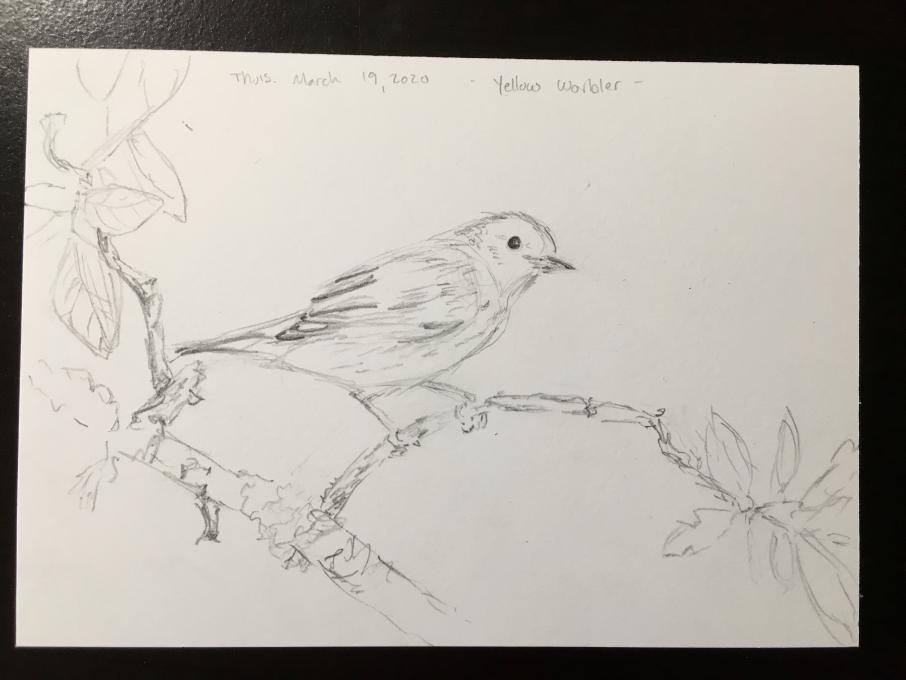The Cornell Lab Bird Academy › Discussion Groups › Nature Journaling and Field Sketching › Jump Right in!
-
This was a fun challenge because I haven’t made a sketch in many years! I don’t think any of it came easily...except maybe drawing the leaves. All the proportions of the warbler were challenging to me, and I’m not so pleased with the head/ bill. Also, I have not used this type of pencil before, so discovered how easily the lead is smeared when adding color. 2. I would not have noticed the subtle lighting on his eye and bill if I hadn’t been asked to draw it..nor would I have noticed the soft feathering on his belly. Such a sweet little bird. I don’t know that this would make a big difference in nature journal, since I am trying to capture a memory. However, the details are most helpful when trying to make identifications.

-
I really enjoyed drawing this yellow warbler. Drawing a bird really opens up a whole new experience and perception of them. You really start noticing things like texture, posture, expression, identification features you may not have noticed before as well as the surrounding foliage. You may never notice these things to the same extent if you just take a photograph. This definitely gives drawing in the field an advantage for noticing and appreciating what you are seeing in front of you. A picture does have the advantage of exact proportion and colouring. I found getting the textures right while doing this drawing challenging; such as the soft feathers on the upper back of the bird and by the birds legs as well as the twig it stands on.

-
Lovely sketch Tallula. Were these charcoal pencils or graphite?
-
-
1. Woof. I probably shouldn't have looked at other drawings before responding. My anxiety about drawing really came out. By comparison, I feel a bit like a toddler and I've never used watercolors before so I just stuck with the pencil. I'm a big advocate of the "drawing to see" method in ethnography but I also recognize that drawing is not easy, especially for adults who have never drawn before. Nothing came easily but I do feel like I thought about the photograph more than I normally would, simply by having to draw it. The feet...the feet were so challenging for me. And proportions too, I guess? I was trying to think about how this drawing might work if I was standing, where I normally birdwatch; just a quick sketch in the corner of my journal. 2. Definitely the sharp, perfectly round and glassy eye. Watching Liz a second time really helped...happy to share because, well, maybe it'll be a glow up warbler.

-
This is so challenging! I'm pleased that my Yellow Warbler is at least recognizable and that I'm actually willing to share it. It took me forever and this is my 1st attempt at using watercolors. I'm not sure it would be recognizable without the yellow (and oops splotchy red breast streaks). I'm a pretty serious birder and have been birding off and on all my life and love iPhone photography - for birds through my spotting scope, but I'm hoping to find more time to slow down, be still, and be more observant of behavior and details; partly with a goal to become an even better birder. This is the perfect course for coronavirus isolation, though getting out in nature is a bit more challenging. I probably wouldn't have noticed the leg color and details of bill size and shape if I weren't drawing this. I love Yellow Warblers and have spent a lot of time in willow thickets in the Sierra with dozens of them during breeding season while my husband was flyfishing.

-
 Easy : ( adavantage with photo) no movement , and I can take my time
but , no context, no memory associate
Easy : ( adavantage with photo) no movement , and I can take my time
but , no context, no memory associate -
I like drawing from a photo as the picture doesn’t move and you can go back and make corrections when you see something you hadn’t noticed earlier. I didn’t use any color on this drawing which I probably should have done as I see by the work of the other artists. I did this drawing last Oct. 10, 2019 at 7 :45pm.

-
 I wasn't entirely happy with how this turned out, found it hard to get the proportions right and spent too much time fiddling with it. Found it difficult to get the angle of the beak right and the positioning of the legs - details that I probably would not have observed so closely had I not been trying to draw it.
I wasn't entirely happy with how this turned out, found it hard to get the proportions right and spent too much time fiddling with it. Found it difficult to get the angle of the beak right and the positioning of the legs - details that I probably would not have observed so closely had I not been trying to draw it. -
 I was nervous about it at first, but once I got going I got more comfortable. I photograph the birds in my backyard a lot. What noticed about drawing/painting is paying more attention to small details. But of course the advantage to photography is it is quick. My goldfinches would be long gone by the time I drew them!
I was nervous about it at first, but once I got going I got more comfortable. I photograph the birds in my backyard a lot. What noticed about drawing/painting is paying more attention to small details. But of course the advantage to photography is it is quick. My goldfinches would be long gone by the time I drew them! -
I love the color and how delicate the bird looks. 🤗
-
I love this!
-
-

-

-
My proportions were a bit off - I made him a bit slimmer than he actually is, but it was fun to get back into drawing. I found the ability to see small details for a long time was great, but it would also be nice to incorporate notes about behavior, interactions, etc. It was also great to notice the leaves, and the different color variations of the bird.

-

-
My sketch came out better than I expected, I'm happy with it and it'll b interesting to see what it will be like later. Easier part of the sketch for me was filling in the sketch/shading of the bird, the hard part was getting an outline with proportions! Details of the wings are hard as well. I probably wouldn't have paid much attention to the birds feet/nails in such detail and definitely wouldn't have noticed the type of leaves or the lichen on the branches. I think noticing the little details can make a difference in nature journaling as it's these details that can give you a better idea of the subject you're looking at and its behaviors. Any additional details gives more information to the big picture.

-
The color matching was difficult. I noticed movement more through drawing.
-
 1. I got this new paint and brush set and I’m still getting used to it. I overloaded my brush a few times and got my sleeve in some paint so there are some splotches. 2. I think I had to look a lot more carefully at the colors in order to paint it.
1. I got this new paint and brush set and I’m still getting used to it. I overloaded my brush a few times and got my sleeve in some paint so there are some splotches. 2. I think I had to look a lot more carefully at the colors in order to paint it. -
I, too have the watercolor packet that you have in your picture. I find it very portable for day trips. Your color matches look good!
-
-
 1. Working with watercolor is hard for me. I always end up using too much water and my colors all bleed together.
2. Because I was trying to draw it, I counted the number of black and yellow stripes in the wing, the softness of the feathers around the shoulder, and the curve of the fingers around the claw. I didn't capture all of those details accurately, but I looked at it much more closely than I would have otherwise.
1. Working with watercolor is hard for me. I always end up using too much water and my colors all bleed together.
2. Because I was trying to draw it, I counted the number of black and yellow stripes in the wing, the softness of the feathers around the shoulder, and the curve of the fingers around the claw. I didn't capture all of those details accurately, but I looked at it much more closely than I would have otherwise. -
1. I felt terrified. Where do you start! I was also worried it would not turn out well and I would lose confidence in my abilities. Reflecting afterwards – I am my own worst critic, it turned out better than I thought it would. I am still nervous to post it, but thats why we are all here right! Overall I am excited to see what I improve on when this course is finished. The body outline seemed easy. I enjoyed the lichen patterns too. I felt the texture of the feathers where hard to capture. 2.I really tried to pay attention to what feathers where black vs yellow in the wings. I was thoughtful on my lichen, trying to distinguish the different types. I think in journaling in real life it will be hard to capture all the colors, patterns, and details of the bird. Warblers are not in one spot for very long! I will have to learn to take a good look and try to remember as much as can.

-
 I felt not very confident going in to this, but the results turned out pretty well, although I am more accustomed to drawing larger birds. A detail that I Would have missed would most likely be the feather detail. This would make a big difference.
I felt not very confident going in to this, but the results turned out pretty well, although I am more accustomed to drawing larger birds. A detail that I Would have missed would most likely be the feather detail. This would make a big difference. -

-
I use to draw the bird only graphite pen HB Staedler, is correct?
-

-
I love your detail on the branch and leaves!
-
-
As I began, I felt the hesitation that comes with the pressure to "perform" - even though this is course is just for me, I still find myself motivated by a need to achieve. But as I began getting lost in the texture of the branches, the shape of the leaves, the posture of the warbler, the need to be "good" was overcome by an enjoyment of the detail of nature. A look at the photograph reveals a striking yellow bird against a background of green. But with a pencil in hand, trying to recreate the image, I saw all the life that is present in the image. It is not just a branch, but a symbiotic relationship with at least four forms of lichen, not just a yellow bird, but a bird with yellow, grey, deep black, rust orange. He (she?) is not just sitting on a branch, but poised, watchful, alive. In the end, I didn't add color because I like how the rough sketch captures the movement and texture and shape. I feel as though I now know a bit about yellow warblers, and will more easily identify one in the future - a knowledge I wouldn't have just from looking at the photo.

-
nice to be able to capture this image without concern that bird would move! able to check out size of body compared to head. Tried to add color but my paper wasn't good for wet media if I tried to add more than one layer. Ok though because I chose to use a sketchpad I had at home . I noticed how many colors are on this bird that I would have missed if drawing it in nature. When I draw it next I will be able to add those colors.
-

-
Inspired by the journal survey video, I was trying to think about birds' shapes, about how to fill the page, and about how to verbally note the experience in addition to images. Because I wasn't in the field, I borrowed my text from the Cornell Lab overview of the yellow warbler, in addition to writing in my ideas about drawing vs. photographs (for me it's in the timing of detail: drawing invites contemplation of details in the moment, whereas a looking at a photograph, not necessarily taking a photograph, invites contemplation of detail after the encounter has ended). Thinking about shapes actually really did make the drawing easier, but I really struggled with finding a full-page style that I liked. When I first started this course I was all about learning more about drawing anatomy, but now I'm excited to think about developing a visual thinking style that includes both text and image. I definitely don't think I would have paid attention to the moss on the twig if I weren't trying to draw the photograph, and I also don't think I would have noticed how the head of the warbler isn't mottled with other colors. I think it'll definitely make a difference when journaling, but I'm unsure how I'll react to missing detail when confronted with moving and living beings who can remove themselves from the portrait sitting at any moment.

-
Hi, I love the term (and idea of) “a visual thinking style!” Thanks for sharing your process and progress and I commend you for your overall and multi-faceted approach you are taking to this “sketching course.” I too sense opportunities for personal engagement and creating a personalized record that may be shareable, but most importantly represents the full experience of observation, study and appreciation of Nature.
-
@Tom Hi, Tom, thanks for your thoughts!
-
Read More:
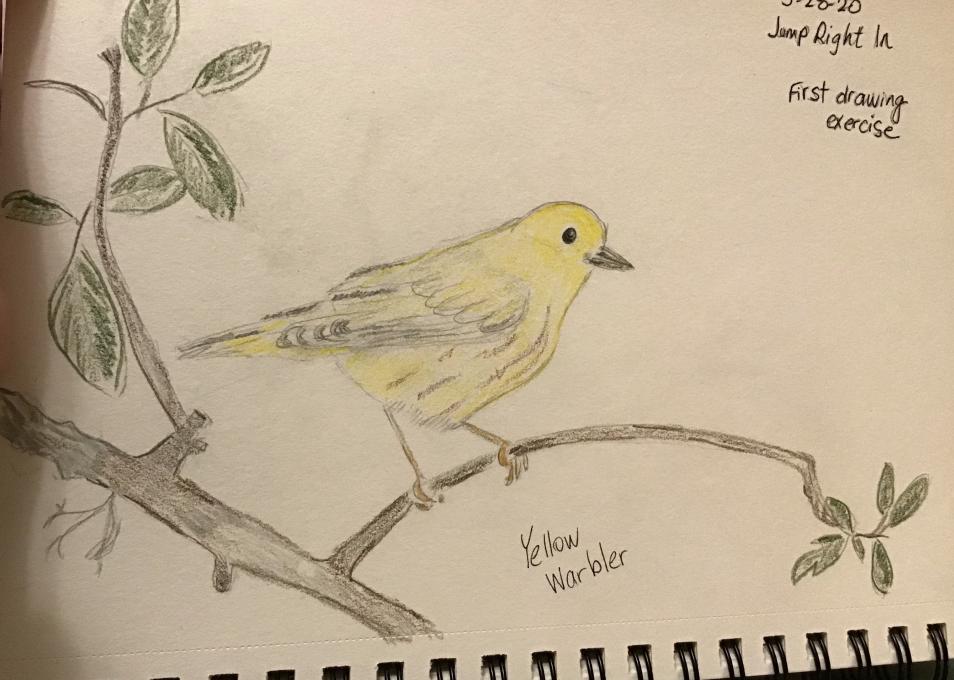
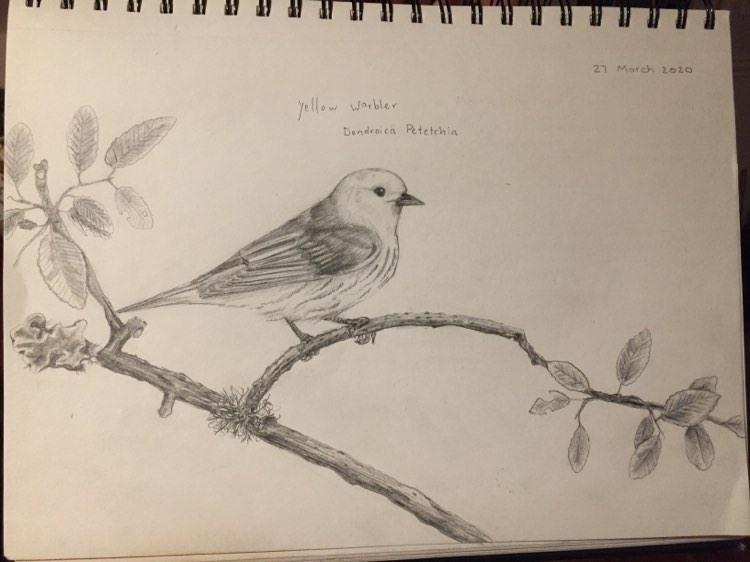


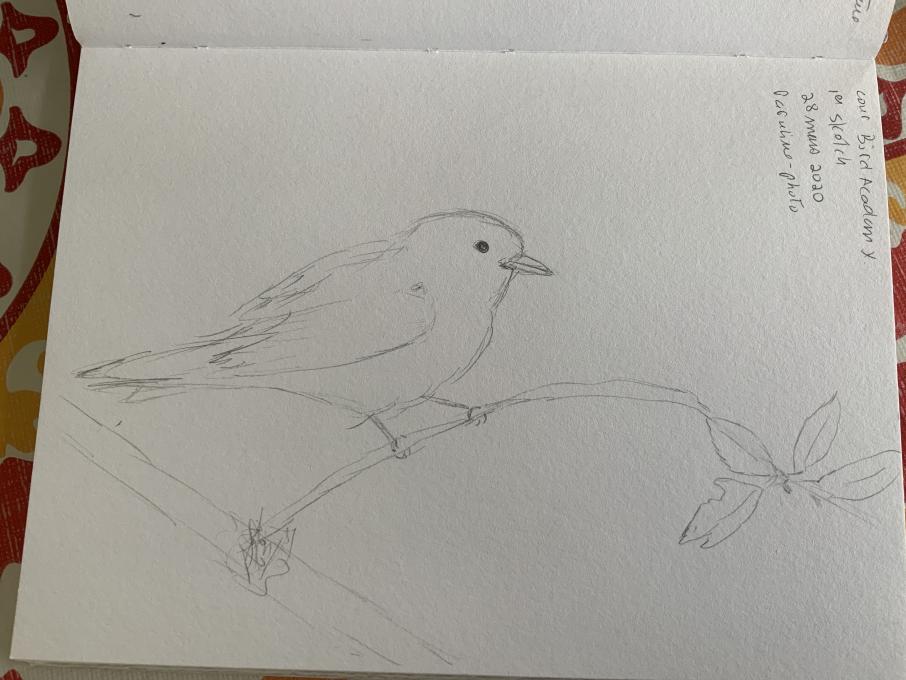 Easy : ( adavantage with photo) no movement , and I can take my time
but , no context, no memory associate
Easy : ( adavantage with photo) no movement , and I can take my time
but , no context, no memory associate 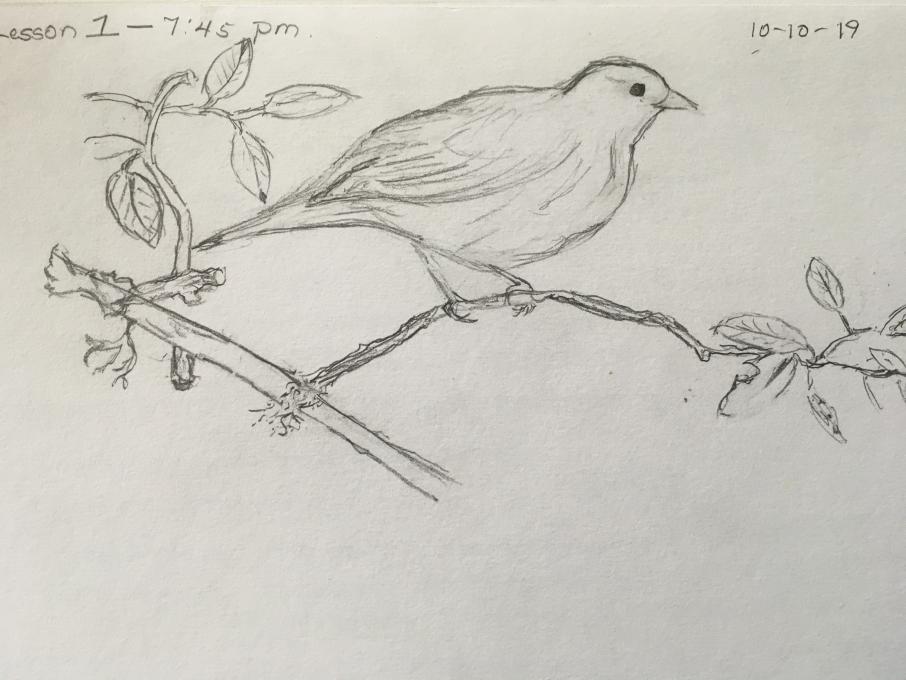
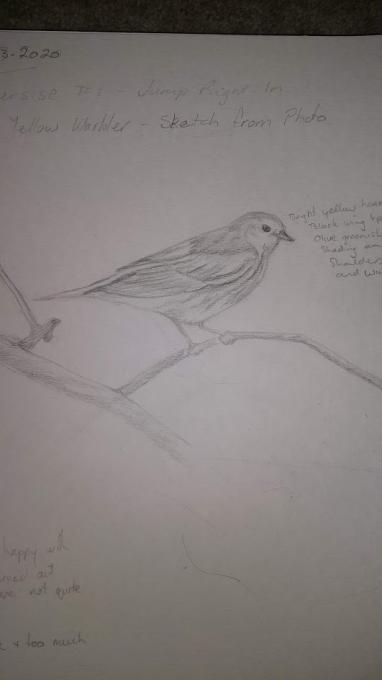 I wasn't entirely happy with how this turned out, found it hard to get the proportions right and spent too much time fiddling with it. Found it difficult to get the angle of the beak right and the positioning of the legs - details that I probably would not have observed so closely had I not been trying to draw it.
I wasn't entirely happy with how this turned out, found it hard to get the proportions right and spent too much time fiddling with it. Found it difficult to get the angle of the beak right and the positioning of the legs - details that I probably would not have observed so closely had I not been trying to draw it. 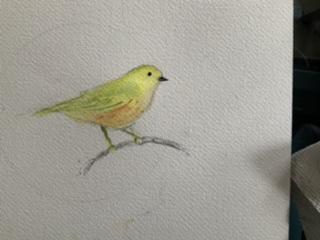 I was nervous about it at first, but once I got going I got more comfortable. I photograph the birds in my backyard a lot. What noticed about drawing/painting is paying more attention to small details. But of course the advantage to photography is it is quick. My goldfinches would be long gone by the time I drew them!
I was nervous about it at first, but once I got going I got more comfortable. I photograph the birds in my backyard a lot. What noticed about drawing/painting is paying more attention to small details. But of course the advantage to photography is it is quick. My goldfinches would be long gone by the time I drew them! 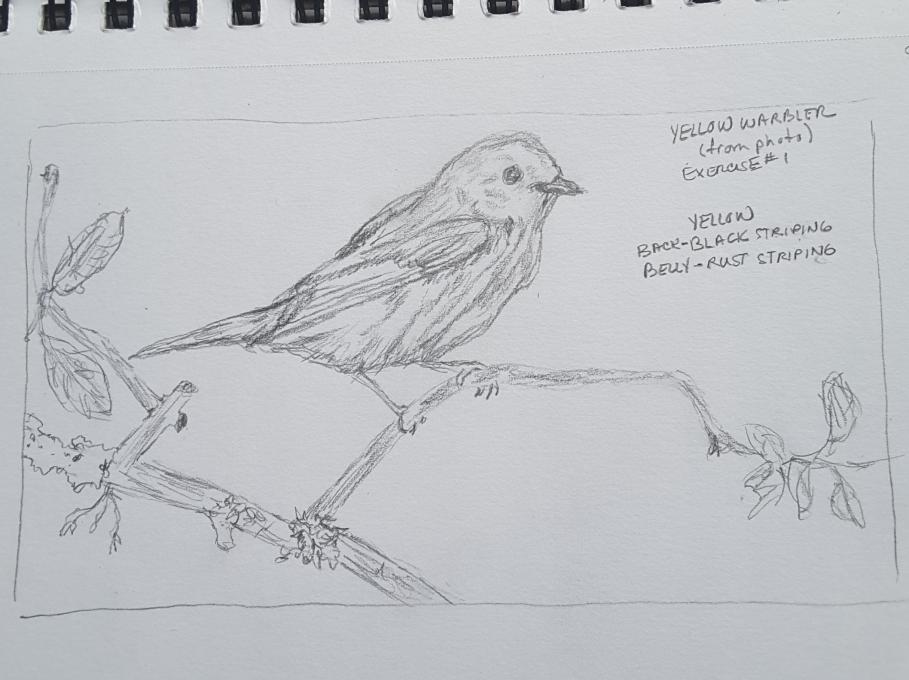
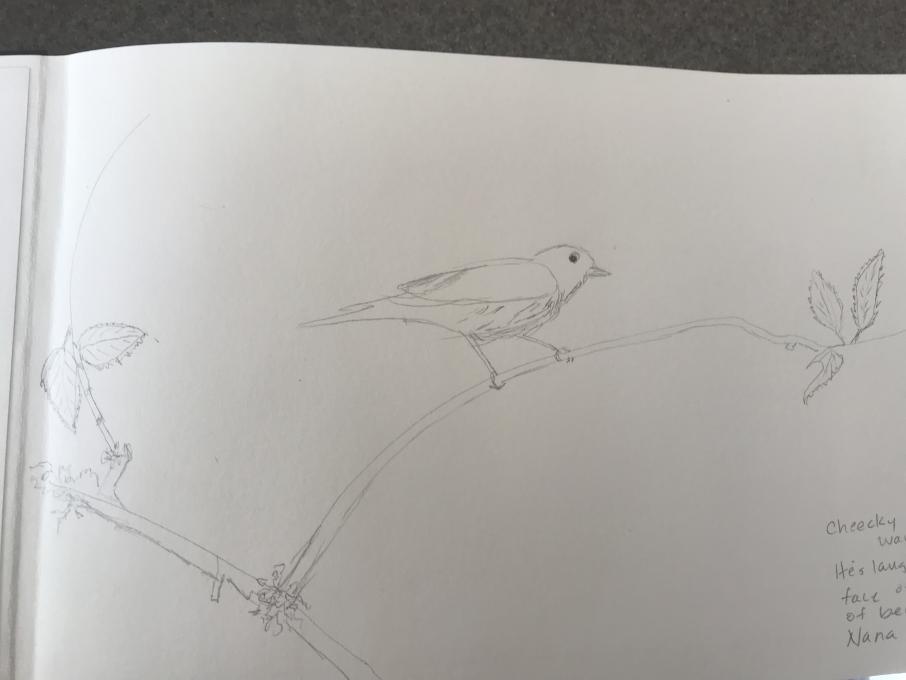

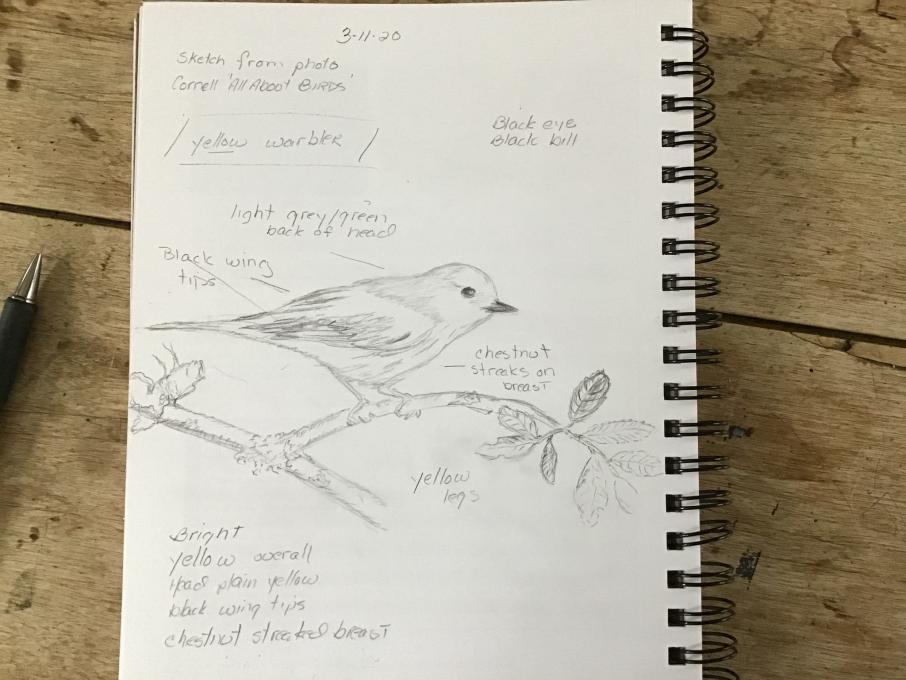
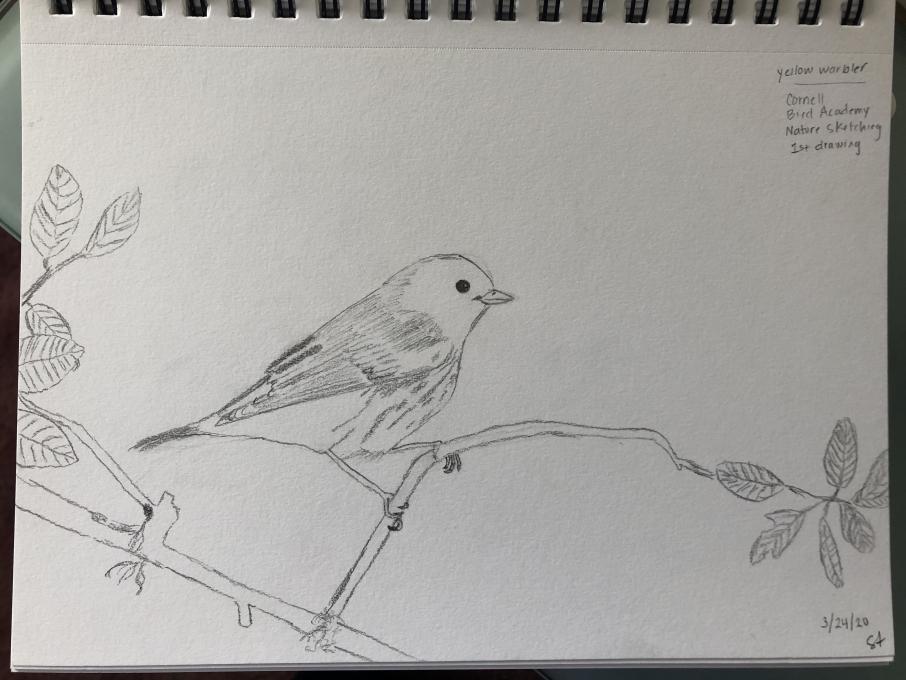
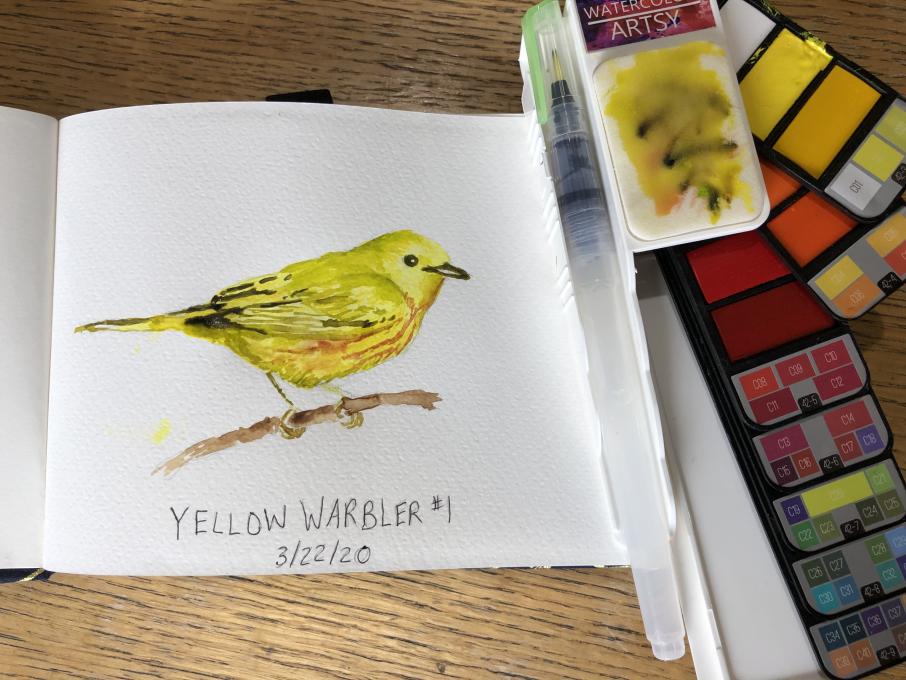 1. I got this new paint and brush set and I’m still getting used to it. I overloaded my brush a few times and got my sleeve in some paint so there are some splotches. 2. I think I had to look a lot more carefully at the colors in order to paint it.
1. I got this new paint and brush set and I’m still getting used to it. I overloaded my brush a few times and got my sleeve in some paint so there are some splotches. 2. I think I had to look a lot more carefully at the colors in order to paint it. 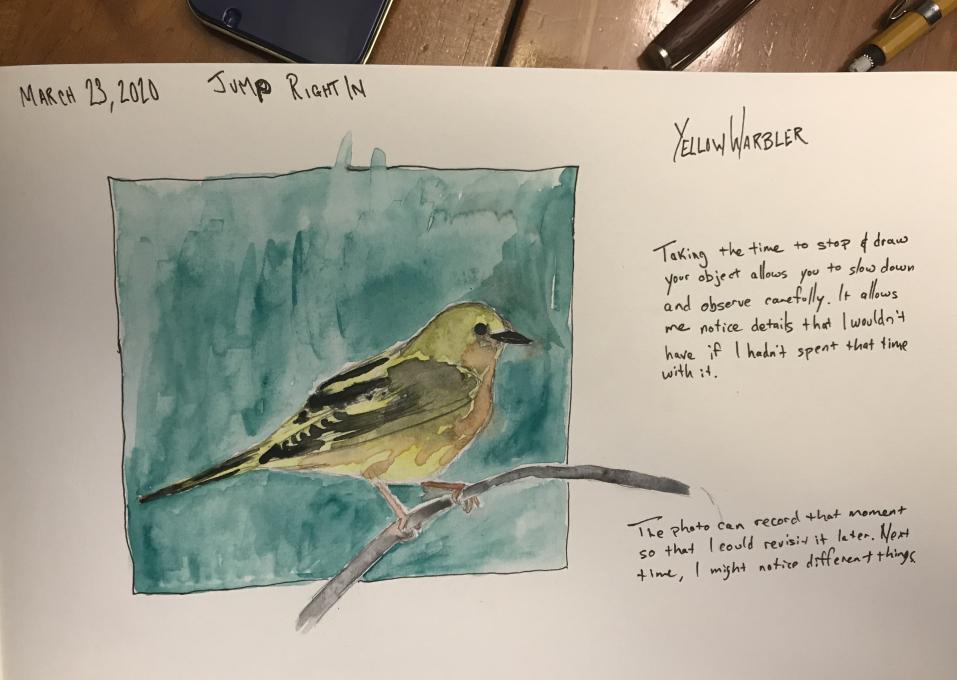 1. Working with watercolor is hard for me. I always end up using too much water and my colors all bleed together.
2. Because I was trying to draw it, I counted the number of black and yellow stripes in the wing, the softness of the feathers around the shoulder, and the curve of the fingers around the claw. I didn't capture all of those details accurately, but I looked at it much more closely than I would have otherwise.
1. Working with watercolor is hard for me. I always end up using too much water and my colors all bleed together.
2. Because I was trying to draw it, I counted the number of black and yellow stripes in the wing, the softness of the feathers around the shoulder, and the curve of the fingers around the claw. I didn't capture all of those details accurately, but I looked at it much more closely than I would have otherwise. 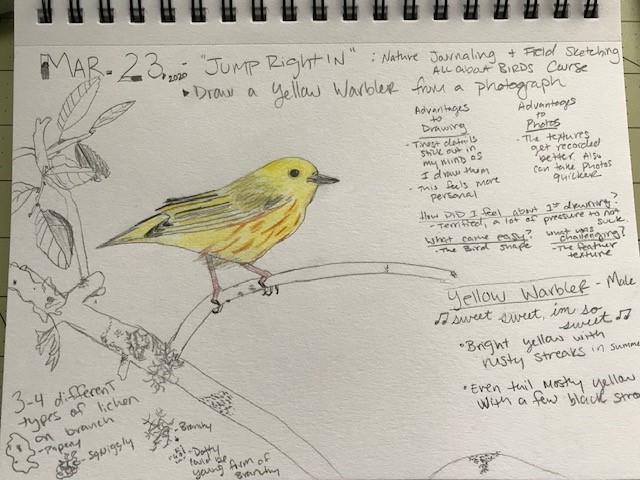
 I felt not very confident going in to this, but the results turned out pretty well, although I am more accustomed to drawing larger birds. A detail that I Would have missed would most likely be the feather detail. This would make a big difference.
I felt not very confident going in to this, but the results turned out pretty well, although I am more accustomed to drawing larger birds. A detail that I Would have missed would most likely be the feather detail. This would make a big difference. 

